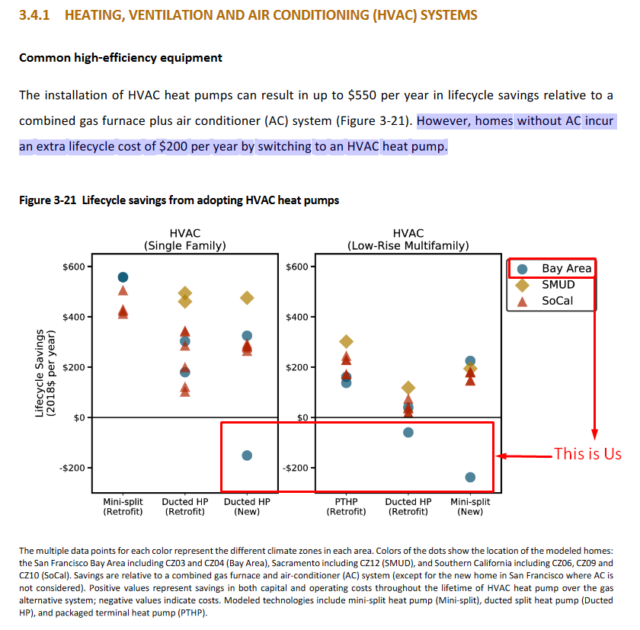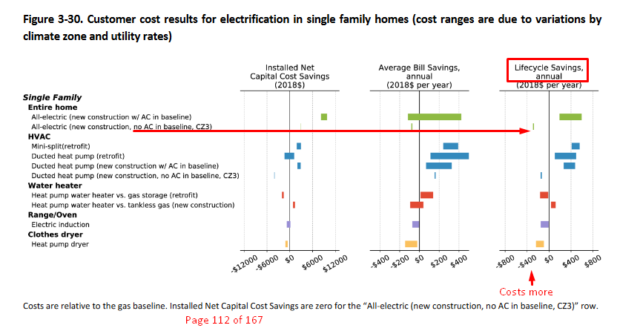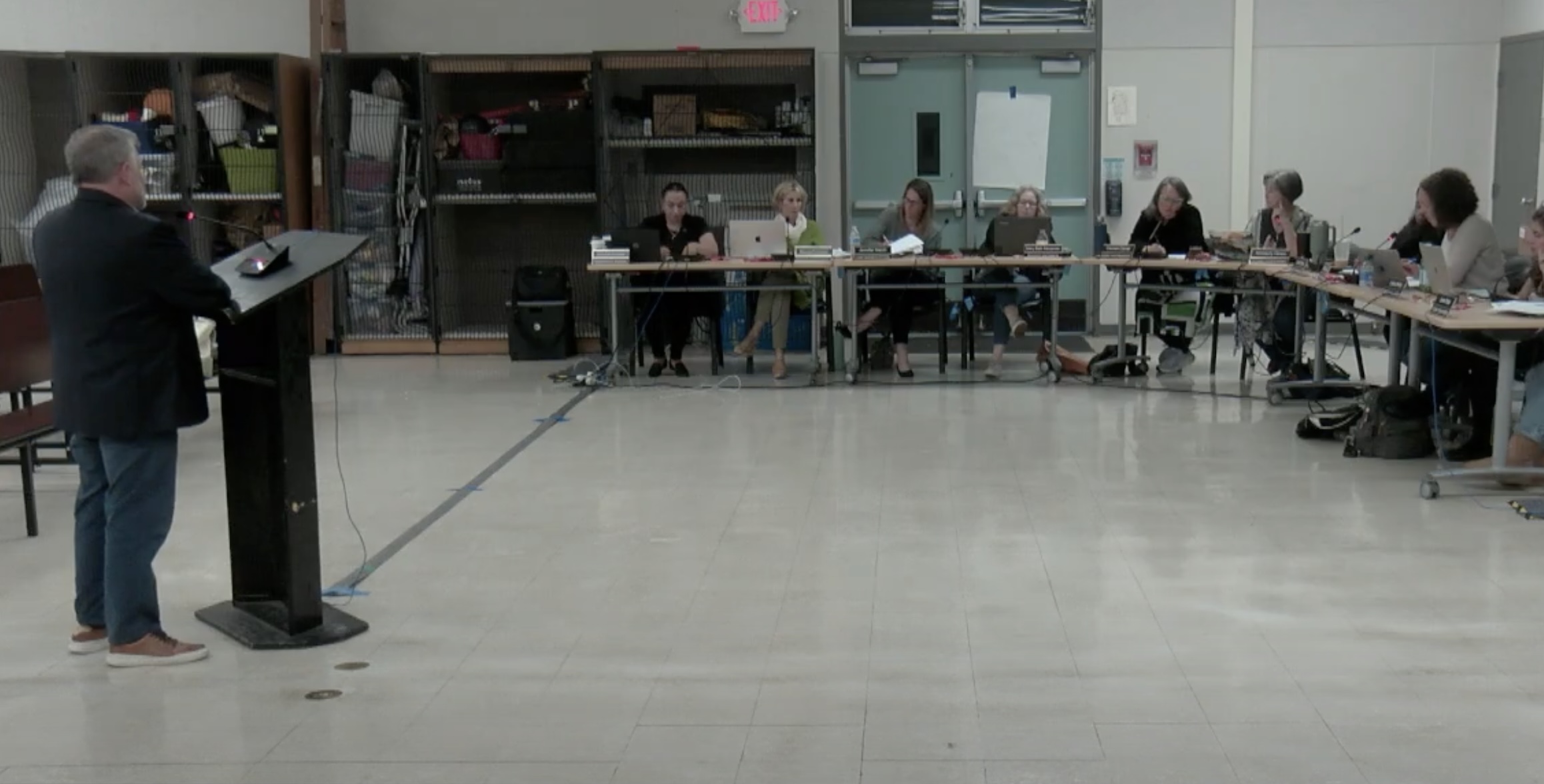|
Getting your Trinity Audio player ready...
|
Footnotes: to use, click the bracketed number and then click your browser Back button to return to the text where you were reading.
Images: Click to enlarge for improved readability in a new window.
1. The problems are obvious, Risk and Cost. The Risk is first, PG&E. The extra Costs are admitted to by the study underpinning this entire initiative, and further exaggerated by SAMCAR[1]. I doubted I’d ever be on the same side of an issue with the Real Estate Lobby, but they have also fingered the costs of this proposal as being several tens of thousands of dollars per house.
2. The less obvious problems are the secondary effects of this policy. First, imagine thousands of diesel-fueled emergency generators going off for days at a time when PG&E fails again. Not only won’t you get to sleep, but the greenhouse gas (GHG) emissions of THAT scenario are not included in the analyses. Second, consider the effect on Affordable Housing, or the affordability of housing. Not good. Several constituents have complained that increases in water, sewer, and garbage rates – and now this – are forcing them out of the area. Electrification is another step towards Gentrification – hey, at least Gentrification pays for itself, but it’s not the social policy HMB is promoting elsewhere.
3. Finally, it’s the wrong regulatory approach, as in – the more expensive and less efficient regulatory approach. Dr. Chris Knittel of MIT has done studies showing that the swath of regulations surrounding emission regulations are 2.5 to 7 TIMES more expensive than a simple Carbon Tax/Fee or FeeBate (where you pay based on carbon use, then everyone gets an equal dividend returned, thus those who use less come out ahead).[2]
4. So, what to do: Well, fix PG&E. Consider instead promoting more solar and wind on residences, and battery backups. Consider micro-grids and a truly more resilient local electricity network run locally, rather than depend on PG&E. And a statewide Carbon FeeBate.
Says Who?
I’d like to think my credentials as an advocate for Clean Technology are pretty good [3], so I don’t take lightly publicly opposing a suggestion on how to combat the Climate Crisis and preserve life as we know it on our planet. But let’s look at the information presented, and NOT presented, in support of the HMB electrification policy: The material on that page comes substantially from a centralized source: PCE/OOS/SVCE Recommended Reach Codes from Peninsula Clean Energy. In fact, that group spoon-feeds any city interested with a sample slide deck for city staff to use, sample building codes to adopt, oh, and financial incentives. The key research and justification for electrification I find on that site is this consultant study: Residential Building Electrification in California.[4]Let’s look at some of the claims and analyses in that study and you can easily understand what makes sense, and what doesn’t, in their electrification policy. (Quoted items are from their study) To start, here is the HMB staff recommendation: “Conduct a study session and provide staff direction to draft a reach code ordinance to increase energy efficiency and reduce greenhouse gas (GHG) emissions by limiting natural gas usage in buildings”. … Note that it says nothing about Risk and Cost, nor considering other alternative policies. First, the claimed benefits are:
- All-electric homes are less expensive to build
- “Safer and healthier to live in ” without natural gas
• Less asthma
• No risk of carbon monoxide poisoning
• No explosions
• Less fires - One of the goals is: “Increase resiliency “
SAMCAR clearly disagrees with point #1. I accept the items under point #2 – as long as the power is ON. On the last point the slides ‘slide away’ from the truth. For example, with respect to power-shutoffs & resilience a template slide says: “Real problem, but gas does not help. Gas appliance ignition is electric. In emergencies gas is also shut-off. State policy for grid hardening is key”. This omits the obvious fact that gas heaters use a flame-powered thermocouple which DOES WORK even when your electricity is turned off. And MY gas has NOT been turned off when the electricity has shut off. Having heat and hot water is a factor in resilience when PG&E fails us (again). They also ignore what we all know, that wildfire risks and winds cause our power to shut off multiple times every year, sometimes for days. Electricity without a home backup generator (to power SOME of your house), or solid state batteries (like Tesla’s, or these), and natural gas for heating and water, is NOT resilient today.
If the State would take responsibility for “hardening the grid” and delivering reliable, non-stop power, this policy would make more sense. When first elected, I thought Newsom’s first big task would be fixing PG&E because of wildfires, cost and unreliability. Why is PG&E paying dividends to shareholders while costing us billions in mismanagement? Well, regulated monopoly is the answer. Since we’ve had some success in Montara with a socialized water & sewer district (some would disagree), I’m favorably disposed to ‘socialized’ utilities. But the Pandemic got in Newsom’s way, and so does the fact that Southern Calif. has two other utilities, so why should SoCal allow Calif. to operate PG&E for us, unless they also want their utilities “socialized”? Maybe we can trade them water for a state-owned electrical utility we can run more affordably than one paying profits and dividends? But I digress; bottom line: PG&E is NOT reliable out here on the Coast, and people who need non-stop heat will be at greater risk.
4. The standard slide show also claims home fires will be reduced, but note that electric ranges can still cause grease fires, so those claims seem overstated.
5. Some of the results on their slides come from DRAFT, stat studies: e.g. “CEC Workshop June 6, 2019: Draft Results from E3 study on the Future of Natural Gas Distribution in California”
6. The claim “safer and healthier to live in” ignores the current reality of backup generators. They don’t study the noise and climate emissions from the thousands of those devices we’ll all need to survive the next power outage.
There are several other incomplete analyses in that paper, but let’s focus on the Cost issues and some key assumptions which are overlooked in HMB’s presentation. Here are some telling quotes from the consulting study:

7. “However, for homes that do not have AC (modeled as new construction homes in San Francisco), an HVAC heat pump costs about twice as much as installing a gas furnace.”
8. There’s NO air conditioning need here Coastside, yet that’s part of the financial case in favor cited in the consultant study – which looked statewide, including hotter climates.
9. “Heat pump water heaters (HPWHs) cost $1,000-$2,000 per household more than gas storage water heaters (modeled for all retrofit homes).”
10. “However, homes without AC incur an extra lifecycle cost of $200 per year by switching to an HVAC heat pump.” (Page 102 of 167)
11. “Heat pump water heaters (HPWHs) generate lifecycle savings of up to $150 per year over gas tankless water heaters in almost all home applications, but in retrofit homes, gas storage water heaters still appear to be the cheapest option (Figure 3-23).”
12. “Electrifying cooking generally incurs extra lifecycle costs, of up to $150 per year, for all types of homes.”
13. “Electric clothes dryers are more expensive than gas dryers, costing consumers up to $240 more per year in lifecycle costs.”
14. Their summary of findings does not apply to Bay Area: “We assume that all consumers in retrofit homes have or would install air conditioning in the mixed fuel baseline”
15. And what is the impact on our electric grid and any hidden costs or benefits there? “The impacts of load changes driven by electrification in specific locations and distribution systems were not analyzed in this study” (page 116 of 167)
16. “Most homes are not expected to see lifecycle savings from electric cooking and clothes drying given current rate structures, although most lifecycle cost increases were less than $100 per year for each appliance.” (Page 119 of 167)

17. “We only simulated existing homes that include AC in the baseline gas-fueled home, but we do not expect lifecycle savings would occur for homes lacking AC due to the large capital cost increases associated with retrofitting the HVAC functionality to allow air conditioning with a heat pump.”
18. The consultants admit a need to: “Evaluate the customer costs and benefits, and societal costs and benefits of building electrification in the climate zones not evaluated in this study, including colder Northern and mountainous climate zones.”
19. And there are other policies pending – not covered in that study – that will change the affordability of electricity and solar – potentially charging solar users $70/month[5]. Which raises the question, why have solar at all? And the related question: are you trying to solve the Climate Crisis, or improve the returns for PG&E investors? The full extent of all these policies should be in front of us for consideration and voting, rather than forcing piecemeal policies which may actually oppose each other in their effects.
So, the study underpinning this electrification policy doesn’t fully apply in Half Moon Bay. And there’s a further issue: Accountability. The only things certain about this policy are Risk and Cost. But how will the benefits and costs be measured and audited over time, who will do that auditing, and who funds it? What happens if the policy fails in some dimension: costs more, benefits less? What remediation will be provided to correct for those failures? What restitution will be made to those negatively affected? Like much in Government (and Corporate America; see also: Opioids), the answer is: there will be no accountability, unless voters can create it.
Jumping To A Conclusion:
This HMB policy is well-intentioned from a Climate Crisis viewpoint, but it doesn’t appear that the policy they’re promoting is properly suited to the Bay Area – based on their own studies, and I don’t see the evidence that the cost/benefits of this policy: a) include consideration of many alternative policy options, and b) properly account for the risks and costs faced by its residents. Some have accused the councilors promoting these policies of “virtue signalling”, but I can understand the intended pollution benefit. However, the cost/benefit is truly unclear. This looks like a Tax Increase to me, and I thought those had to be approved by a popular Vote.
Speaking of Voting, you will have to decide whether you elected your City Council to serve your interests, or to lead you in new directions that might not have been disclosed when you elected them. What I would say to HMB residents is: you have a City Council election coming up in Nov. 2022; you can decide if you need some new candidates to remedy this policy, if it is adopted.
What would I do, if I were in charge?
1) Get the state to fix PG&E. Once reliable and accountable, reconsider options.
2) If you can’t wait for #1, re-imagine the electrical grid here in San Mateo County, including distributed generation and storage.
3) Pass a National and/or State Carbon Fee and Rebate program. Let people make their own choices about how much they want to pollute, and pay for it.
———————————————————————
FOOTNOTES:
[2] Articles & Papers re: Carbon Tax by MIT’s Chris Knittel
Getting to Zero: Carbon Pricing and its Green Critics
Trade-offs in Climate Policy: Combining Low-Carbon Standards with Modest Carbon Pricing
Sacred Cars? Cost-Effective Regulation of Stationary and Nonstationary Pollution Sources
[3] Dieguez Climate Crisis Credentials:
I’m not a Climate Science Professor, but I’ve been an involved student and activist for sustainability for a long time. In 2003, co-founded the Clean Technology Program for the MIT Club of Northern California, which grew into MIT’s award-winning, largest alumni speaker program. Further, in 2005 we conceived of and spun off a sub-group (for reasons of non-profit tax status) to found the California Clean Tech Open: Cleantech Open — the Largest Clean Technology Accelerator in the World – “Since 2005 Cleantech Open (CTO) has trained over 1600 early-stage clean technology startup entrepreneurs through its annual business accelerator. A majority of CTO alumni have survived the merciless technology startup “valley of death” and gone on to raise $1.2 billion and create over 3,000 clean economy jobs.” Now called the Energy & Environment Series, our group has held speakers, panel sessions, and educational tours with leading scientists, engineers, and policy makers from all over the world.
I have taken the MIT Climate Science Course (it’s online, as most of MIT’s curriculum has been for a decade, and you can take it for free here). I have taught and practiced System Dynamics, the modeling used to produce the Limits To Growth analyses, the first computer analysis showing the requirement for sustainability in human society. And I maintain a Concerned Citizen’s Reading List, which includes many useful references on sustainability and society, with a brief summary allowing the reader to discern the import of each book and whether s/he should read it.
I also wrote A Beginners’ Guide to the Climate Crisis describing in simple terms how our climate crisis is caused, and is proven by fundamental science obvious since grade school, and since the 19th Century.
[4] The consulting study underpinning the Electrification Effort:
[5] PG&E to charge solar customers more? Up to $70 per month
Why PG&E, California utilities want to add new fees for rooftop solar panels
[pdf-embedder url=”https://www.coastsidebuzz.com/wp-content/uploads/2021/10/SAMCAR_Potential-Structural-Costs-of-Electrification-Conversion-090721.pdf” title=”SAMCAR_Potential Structural Costs of Electrification Conversion 090721″]
More From Gregg Dieguez ~ InPerspective
Mr. Dieguez is a native San Franciscan, longtime San Mateo County resident, and semi-retired entrepreneur who causes occasional controversy on the Coastside. He is a member of the MCC, but his opinions here are his own, and not those of the Council. In 2003 he co-founded MIT’s Clean Tech Program here in NorCal, which became MIT’s largest alumni speaker program. He lives in Montara. He loves a productive dialog in search of shared understanding.







Gregg, I’m so glad you looked at the entire picture. After reading your article, it appears that the HMB City Council is fluffing their image by “Virtue Signaling” rather than considering all the facts (like the Coastside “maybe” gets one day a year where people might be wishing they had an air Conditioner to turn on. (One or even two hot days per year don’t justify adding an Air-conditioning unit to my house.)
As for individual solar, it seems that many are making those individual choices, but, I am curious why neighbors haven’t opted for a central solar array to power a community, somehow? We can do that for water or sewer rather than each house having an individual well & septic system. Has no one looked at Community Solar? Or, maybe there are laws against it, based on energy industry lobbying.
Great suggestion CID, one I have considered myself in light of this electrification project. I think it better use of council’s time to investigate the cost of building a community solar array for hmb residents, investigate federal, state, county and local funding/incentives and/or tax on such a project as a referendum. It would be a far more eco-friendly solution that would really make the city of hmb a model as environmental forward thinkers. Bottom line, residents should have choices not dictates.
Also, are there kickbacks or anything being offered to our city or city council to push this agenda? I always think we should follow the money at every level!
Excellent Article!! One point that seems overlooked is “How green is our electricity?” and “What direction will that be going if the drought continues?” According to 2018 data, roughly 48 % of our in state electricity comes from burning carbon. In the future, hydro electric and nuclear generation will likely be decreasing. Imports from northwest hydro will probably also decrease. Imports from southwest generation are probably more highly carbon fueled (?). Looking at these factors, our electricity isn’t all that green and it is likely to get worse if the drought continues.
Always enjoy your analysis of issues and the supporting references and data. The concern I have about the HMB move to sunset natural gas is the analysis that supports it. I haven’t seen it, so I don’t know the details. It’s a big change with costs and benefits and assumptions. Some simple questions – what is the cost per ton of CO2 per home. What is the assumption on electricity costs over the next decade or two. And the assumption of grid capacity and reliability. It’s really an engineering problem in the end. What is the best use of scare resources (especially in HMB) to meet the challenge of climate change.